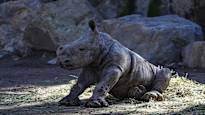Silverio is the third rhino born in South America.
Rare first steps have been taken at the turn of June and July at the Buin Zoo in Chile.
Namely, on June 20, a baby rhino was born in the zoo, named Silverio after the Catholic saint.
The birth, which lasted about four hours, was under the constant supervision of a veterinary team, the zoo says on its website. The cub weighing almost 75 kilograms stood up less than an hour after birth.
Veterinarians declared the newborn male healthy.
Small Silverio is more precisely the southern wide-lipped rhinoceros, which is listed as an almost endangered species. Within a year, only eight southern white-lipped rhinos have been born around the world.
– We are really proud. We have a third rhinoceros born in South America. We are leaders in the reproduction of this species, which has been greatly reduced worldwide, says the director of the zoo Ignacio Idalsoaga on video.
The story of Silverio’s parents, Oliver and Hannah, reportedly began at the zoo in 2013, when they arrived as two-year-olds from South Africa. Silverio has two siblings, Pantaléon born in 2017 and Atanasio born in 2020.
The only threat to rhinos is humans
According to the WWF five species of rhinoceros live in Africa and Asia, some of which are divided into subspecies.
The southern broad-lipped rhino represented by Silverio is one of the big rhinos to watch out for. The species was thought to have died out at the end of the 19th century. In 1895, however, a population of less than a hundred individuals was found in South Africa. Thanks to the revitalization that lasted more than a century, the stock currently has around 16,800 individuals.
The second subspecies of the big rhinoceros, the Zaire wide-lipped rhinoceros, is known to have only two females left.
In addition to the big rhinoceros, the species are the bush rhinoceros and the Sumatran rhinoceros. The Javan and Sumatran rhinoceros living in Indonesia are very close to extinction.
Humans are the only threat to adult rhinos. Due to poaching and habitat loss, some subspecies of rhinoceros have already become extinct.
Source: Reuters
